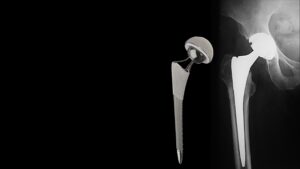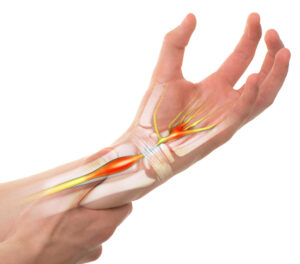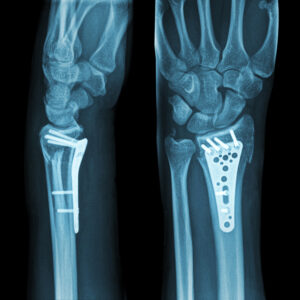
At The Orthopedic Center, we offer several treatment options for back and neck pain and injuries. Check them out by clicking on the links below:

At The Orthopedic Center, we offer several treatment options for back and neck pain and injuries. Check them out by clicking on the links below:

At The Orthopedic Center, we offer several options to treat foot and ankle injuries. To learn more, please click on the links below.
 Although not as frequently as the knee or hip replacement, shoulder replacement is being increasingly performed due to its success in relieving pain from severe shoulder arthritis, chronic tendon tears or severe fractures.
Although not as frequently as the knee or hip replacement, shoulder replacement is being increasingly performed due to its success in relieving pain from severe shoulder arthritis, chronic tendon tears or severe fractures.
Surgeons at The Orthopedic Center are experienced in both, anatomic and reverse shoulder replacement surgery. Set up a consultation to find out if you can benefit from this advanced procedure for shoulder pain.
 The indications to perform this procedure is generally the failure of conservative management resulting in pain that interferes significantly with your activities of daily living.
The indications to perform this procedure is generally the failure of conservative management resulting in pain that interferes significantly with your activities of daily living.
Often misunderstood, joint “replacement” is in fact a “re-surfacing” procedure whereby the orthopedic surgeon removes the worn surface of the shoulder bones including the humerus and the scapula (shoulder blade). The implant is secured to the bone by “press-fitting” it into strong bone or using a cement polymer when the bone is weak.
Your surgeon needs to access the joint by making precise incisions and bone cuts while protecting important tendons, ligaments, blood vessels and nerves. Your surgeon will not only remove the old joint surfaces but she or he will also correct any deformity caused by the arthritis.
Typically you will stay in the hospital after surgery for one night, but in special occasions some patients will be allowed to go home on the day of surgery.
Physical therapy following your surgery is an important components of the entire process and it is mandatory in order to guarantee a successful outcome. In general, physical therapists working with you have been selected by your surgeon based on their ability to deliver good consistent therapy outcomes.
Shoulder joint function and movement depends on having healthy rotator cuff muscles. The rotator cuff muscles are the deeper layer that it is immediately adjacent to the joint itself. The function of the rotator cuff is to, not only move the joint, but more importantly to maintain the humeral head centered on the shallow socket while it is moving.
If the rotator cuff tendons are healthy your surgeon will choose an anatomic implant that replicates the shape and size of your joint. However, if your rotator cuff tendons are torn or damaged, the surgeon will choose a special design that creates stability by reversing the geometry of the joint: The reverse shoulder arthroplasty.
Since the advent of this revolutionary design in the treatment of arthritis of the shoulder associated with a rotator cuff tendon tear, thousands of patients have been able to regain pain free function. The reverse shoulder design also allows surgeons to treat complex shoulder fractures.

Total hip replacement is a very successful surgical procedure in practice since the 50’s. It has been perfected over time and now it is routinely performed by Orthopedic Surgeons. It is in fact the one of the most successful medical procedures when it comes to improvements in overall health and quality of life.
Providers at The Orthopedic Center are experienced at determining if a total hip replacement would be appropriate for you.
 Total hip replacement becomes an treatment option when conservative management has failed and the pain is interfering significantly with your activities of daily living. Only you and your orthopedic surgeon can decide if this option is appropriate for your particular situation.
Total hip replacement becomes an treatment option when conservative management has failed and the pain is interfering significantly with your activities of daily living. Only you and your orthopedic surgeon can decide if this option is appropriate for your particular situation.
For the performance of this operation your orthopedic surgeon will gain access to your hip joint utilizing one of many safe surgical approaches. Once the joint is adequately visualized, the orthopedic surgeon will remove the femoral head and the surface of the hip socket (acetabulum) and will replace them with size-matched high-tech materials.
The implants are secured to the bone generally by “press-fitting” the implant into the prepared bone. Press-fitting really means that when the bone is prepared, the space created is just a little smaller than the implant and when the implant is impacted into the bone it will be tightly held by it. The titanium implant surface that contacts the bone has a porous finish that will encourage bone “ingrowth”. When completed in about 6 to 8 weeks, this bone ingrowth will provide a very secure biologic fixation.
 Occasionally, when the bones are thin and relatively weak, the surgeon may choose to “cement” the femoral (thigh bone) component instead of press-fitting it. The poly-methyl-methacrylate (PMMA) cement will provide an extremely durable and strong fixation of your implant.
Occasionally, when the bones are thin and relatively weak, the surgeon may choose to “cement” the femoral (thigh bone) component instead of press-fitting it. The poly-methyl-methacrylate (PMMA) cement will provide an extremely durable and strong fixation of your implant.
Total hip replacement is arguably the most successful of all joint replacements. The great majority of patients experience great relief of pain immediately after the procedure. The most significant advances in hip replacement surgery are related to our improved understanding of materials, bone fixation, joint stability and implant design.
Recently, the surgical approach is being hailed as the primary factor determining the success of this intervention. The direct anterior approach is being widely marketed to patients with claims of less muscle damage, improved stability, less pain, faster recovery, and greater overall superiority when compared to all other surgical approaches. However, when high-quality scientific studies compare surgical approaches performed by expert and experienced hands, there is little difference, if any, between the anterior and the mini-posterior hip approaches with regards to short and medium-term results.
An unfortunate consequence of all the marketing is that it is unfairly shifting the focus away from the real goal of hip replacement surgery: TO PROVIDE YOU WITH A STABLE, PAIN-FREE AND DURABLE JOINT. To achieve this goal reliably, your surgeon will carefully choose the surgical technique and the implants used based on safety, experience, quality and an excellent track record of implant durability.
For a more in-depth discussion of hip replacement surgical approaches click the link below.
 Once conservative treatment no longer provides lasting relief of pain, surgery becomes an option you need to discuss with your orthopedic surgeon.
Once conservative treatment no longer provides lasting relief of pain, surgery becomes an option you need to discuss with your orthopedic surgeon.
Partial or total knee replacement surgery are excellent options if you want to remain active and eliminate the pain of an arthritic joint.
At the Orthopedic Center your surgeons are Fellowship-trained and experienced in knee replacement surgery.
 Often misunderstood, knee “replacement” is in fact a “re-surfacing” procedure whereby the orthopedic surgeon removes the worn surface of the knee bones including the femur, the tibia and the patella (kneecap) and replaces them with size-matched high-tech materials. The prostheses are secured to the bone using a very strong polymer or bone cement.
Often misunderstood, knee “replacement” is in fact a “re-surfacing” procedure whereby the orthopedic surgeon removes the worn surface of the knee bones including the femur, the tibia and the patella (kneecap) and replaces them with size-matched high-tech materials. The prostheses are secured to the bone using a very strong polymer or bone cement.
Your surgeon needs to access the joint by making precise incisions and bone cuts while protecting important tendons, ligaments, blood vessels and nerves. Your surgeon will not only remove the old joint surfaces but she or he will also correct any deformity caused by the arthritis.
Typically you will stay in the hospital after surgery for at least one nights, but depending on fitness, some patients will be allowed to go home on the day of surgery.
Physical therapy following your surgery is an important component of the entire process and it is mandatory in order to guarantee a successful outcome. In general, physical therapists working with you have been selected by your surgeon based on their ability to deliver outstanding results.
 While a complete knee replacement is effective treatment in a knee that is globally affected by arthritis, a partial knee replacement may be the answer if the arthritis is limited to one side of the knee only.
While a complete knee replacement is effective treatment in a knee that is globally affected by arthritis, a partial knee replacement may be the answer if the arthritis is limited to one side of the knee only.
The knee is composed of three separate compartments. Osteoarthritis sometimes develops in only one compartment of the knee, while the other two compartments remain relatively healthy. Patients who have osteoarthritis in only one compartment may be candidates for partial knee replacement.
The advantage of a partial knee is that it resurfaces only the damaged cartilage of the knee, preserving the undamaged cartilage. Therefore the surgery can be truly minimally invasive, and there will be less pain and faster recovery time when compared to a total knee replacement. More and more these surgeries are being performed as outpatient procedures allowing you to go home immediately after the operation
Ultimately, the main advantage of a partial knee replacement today is that it accomplishes effective relief of pain while allowing the knee to feel more “normal” due to the preservation of cartilage and ligaments. You and your surgeon at The Orthopedic Center will determine if a partial knee is appropriate for you.
Oxidized Zirconium knee implants promise to deliver more than 30 years of service. Coupled with the advanced Journey II implant design it will provide improved kinematic function, lasting pain relief and stability.
The mobile bearing Oxford Partial Knee is the most widely used and clinically proven partial knee in the world. Published long-term clinical results demonstrated a 92.4% survivorship at 10 years, 94.0% at 15 years, and 91% at 20 years.
 Hands and wrists are prone to injuries such as fractures and tendon ruptures. They are often affected by overuse conditions such as carpal tunnel and tendinitis. Degenerative joint arthritis are also a frequent cause of pain and disability.
Hands and wrists are prone to injuries such as fractures and tendon ruptures. They are often affected by overuse conditions such as carpal tunnel and tendinitis. Degenerative joint arthritis are also a frequent cause of pain and disability.
At The Orthopedic Center our providers are fellowship trained in wrist and hand surgery. They are versed in the treatment of common conditions as well as complex reconstructive procedures for wrist and hand arthritis.
Carpal tunnel syndrome
Cubital tunnel syndrome
Guyon canal syndrome
Wrist and hand fractures
Snapping finger correction (trigger finger)
Palmar fasciitis (Dupuytren’s contracture)
Tendonitis, and tendon repairs and releases.
Wrist and hand arthritis
Wrist and hand ganglion cysts and growths
 Carpal tunnel syndrome is a common condition that will cause pain, tingling and numbness to the hand. If left untreated it can progress to weakness and loss of fine motor control in the hand.
Carpal tunnel syndrome is a common condition that will cause pain, tingling and numbness to the hand. If left untreated it can progress to weakness and loss of fine motor control in the hand.
Carpal tunnel syndrome is cause by the progressive compression of the median nerve as it crosses the wrist to enter the hand. The carpal tunnel is a fairly rigid structure that not only contains the median nerve, but also nine hand tendons.
The diagnosis of this syndrome can be made by history and physical examination. Sometimes electrodiagnostic (EMG) testing is needed to further assess the severity.
Initially conservative management is attempted and it works well in early and mild cases, especially if the cause can be identified and eliminated. This consists of bracing, stretches and at times a corticosteroid injection may be given.
Surgical decompression of the nerve is necessary if there is no improvement with conservative measures, the compression is severe and if muscle weakness and atrophy are occurring. It is an outpatient procedure that carries a very high success rate.
 Wrist fractures are a common injury. They usually occur after a fall, a motor vehicle collision or a sports injury.
Wrist fractures are a common injury. They usually occur after a fall, a motor vehicle collision or a sports injury.
A number of different bones in your forearm and wrist can be involved. However, the most common one is the distal portion of the radius, a forearm bone.
Treatment of wrist fracture may include a number of options. From simple immobilization in a splint, to a cast or surgical repair if the pieces are too displaced or unstable. It is important that the bones be place in optimal alignment. It will take approximately 6 weeks to heal.
Surgeons at The Orthopedic Center have many years of experience treating simple and complex injuries to the wrist and hand. Make an appointment today for a consultation regarding your injury